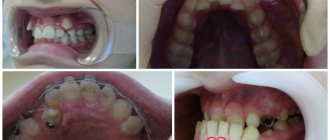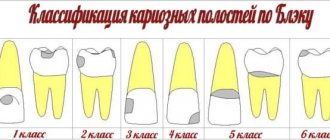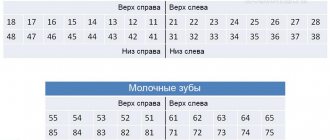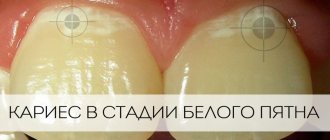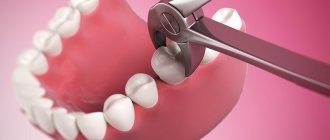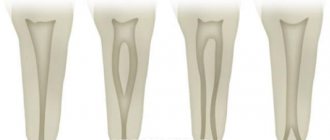4376
The abnormal arrangement of some teeth or the entire jaw row not only does not look aesthetically pleasing, but also creates certain dangers for them.
One of the problems with which a considerable number of patients turn to dentists is pathological protrusion of the front teeth forward.
The disease is called protrusion or vestibular (buccal or labial) position of teeth.
A timely visit to the dentist allows you to get rid of excessive inclination of the incisors and get an ideal smile.
Causes
The occurrence of abnormal vestibular inclination of the anterior teeth is often associated with the following reasons:
- Lack of space for the growth of permanent incisors after the loss of primary incisors. As a result, teeth grow in the direction where they have enough space.
- Excessive crowding of bone organs.
- The habit of frequent finger sucking in childhood , as a result of which the upper incisors are observed to move forward, and the lower ones, on the contrary, back. Often, after eliminating the action that provokes the pathology, it will eliminate itself in the near future without additional measures.
- Incorrect placement of the tongue in the oral cavity in its relaxed state.
- The presence of excess free space between teeth due to the presence of diastemas or three.
- Too late loss of primary teeth in childhood.
- The presence in the dentofacial row of additional elements exceeding the complete number.
- Macrodontia is an increase in the size of some organs , which reduces the space for the proper development of others.
- Initial pathological location of the primordia of milk and permanent teeth.
- Predominance of mouth breathing.
Find out whether it is possible to put braces on crowns and how the procedure is carried out.
Let's look at the design of aesthetic sapphire braces here.
At this address https://orto-info.ru/zubocheliustnye-anomalii/zubov/kolichestva/skuchennost-i-sposobyi-ustraneniya-problemyi.html we will talk about methods for correcting crowded teeth in the lower jaw.
Protrusion after braces
Protrusion can occur during or as a result of orthodontic treatment using a corrective apparatus. Deviation of teeth from a given position after removal of braces is not a rare phenomenon. The thing is that after removing the system, there is no longer any external pressure on the teeth, so the reverse process begins. The teeth strive to return to their original position, which until recently was prevented by orthodontic construction. In a number of situations, such a problem may arise due to incorrect treatment, that is, an elementary mistake by the orthodontist.
To prevent the development of protrusion after braces, it is important to take the retention period responsibly. After removing the corrective device, the orthodontist installs retainers - mouthguards or thin wires that fix the teeth in the desired position.
Retainers
On a note! Experts disagree on how long the retention period should last on average. Most practicing orthodontists are inclined to believe that this period should last at least twice as long as the orthodontic treatment process itself. But everything, of course, is individual.
Before installing an apparatus to correct your bite, it would be a good idea to consult with a specialist in advance about the retention period. Installing retainers allows you to prevent subsequent tooth curvature and consolidate the results after a course of wearing braces.
Classification
Dentists distinguish several types of protrusion of elements of the jaw row:
- Bimaxillary protrusion is characterized by a change in the position of the incisors on both jaw rows simultaneously. This situation may be accompanied by the inability to completely close the jaws and lips.
- Protrusion of the upper jaw is a pathological forward movement of the incisors of the upper dentition.
This pathology is accompanied by insufficient development of the orbicularis oris muscle and shortening of the upper lip. In a relaxed position, the oral cavity remains slightly open. - Mandibular protrusion is defined as excessive forward inclination of the incisors located in the lower dentition.
Symptoms
Timely detection of abnormal inclination of incisors ensures faster and more effective correction of the problem.
Since this pathology can be observed both with permanent and during mixed dentition, it is worth paying attention to the following symptoms inherent in protrusion:
- Excessive forward protrusion and outward turning of the lips . This symptom may not be very noticeable externally in people with full lips, while with sufficiently thin lips this pathology will lead to a violation of the aesthetic appearance of the face.
- Inability to close lips completely . A situation in which, in a relaxed position, the gap between the lips reaches 4 mm is considered pathological.
The severity of these symptoms depends on the severity of the pathology. Signs can be either not too noticeable or reduce the aesthetic appearance of a person.
Prevention
To prevent the formation of dental anomalies, it is recommended:
- During pregnancy, avoid the negative influence of external factors that can lead to the formation of dental anomalies in the unborn child.
- Stop using pacifiers and bottles for babies in a timely manner.
- Introduce the first complementary foods on time.
- Monitor the sequence of eruption of primary and molar teeth.
- Eliminate the formation of bad habits in the child, monitor posture.
- Treat pathologies of the ENT organs in a timely manner and avoid their chronicity.
- After orthodontic treatment, use retainers or other fixatives that allow you to consolidate the result.
Correcting the anomaly
In most cases, dentists recommend correcting the abnormal inclination of the front teeth in the late mixed or early permanent dentition.
The choice of treatment method depends on the severity of the pathology and the presence or absence of free space for tooth movement, and is based on an external examination and X-ray data.
To correct the pathological inclination of the incisors, dentists resort to one of the following treatment methods.
Orthodontic
During mixed dentition, protrusion is often accompanied by the presence of excess space between the teeth. If the anomaly is not visible from the outside, dentists recommend waiting for a permanent bite and the eruption of all the complete elements of the jaw row.
Minor tooth protrusion, defined as class I according to Engle's classification, is characterized by natural closure of the molars and the presence of a problem exclusively in the incisor area.
In most cases, dentists decide to carry out conservative therapy.
The choice of a specific orthodontic design depends on the degree of incisor inclination:
- At the initial stage of forward displacement of the bone organ , dental or dentogingival equipment is used, supported by molars or intraosseous implants.
- Protrusion as a result of the presence of tremata and diastemas is eliminated by retraction of teeth thanks to non-removable structures - bracket systems placed on the incisors and rings fixed on the molars.
With the help of arches with closing hinges, inclined incisors take a natural position. - For protrusion without deep overlap, removable structures, such as the Hawley plate, are used.
This device is characterized by the presence of clasps and a vestibular arch, due to which pressure is exerted on the displaced teeth and their movement to the required position. With the help of an arch, teeth are displaced at a speed of up to 1 mm per month. - Protrusion, supplemented by occlusal contact of dental units , is eliminated through the use of fixed structures. Most often, in such cases, a bite pad is used.
- In the presence of deep incisal overlap, elimination of protrusion in the upper jaw is carried out only after vertical bite therapy. To correct the position of the mandibular incisors, extraoral traction is most often used.
Hardware-surgical correction
The method of surgical elimination of abnormal inclination of bone organs is used quite rarely. The indication for its use is pronounced protrusion of teeth in both jaws at the same time.
Often the surgical therapy process is carried out as follows:
- one premolar is removed from each side of both jaws;
- a U-shaped osteotomy of the anterior compartment of the jaw row is performed;
- the jaw fragment together with the teeth moves to the required position;
- the displaced area is fixed in the area of the osteotomy for the period necessary for the healing of the jaw.
Combined hardware-surgical therapy is much more often used. She involves removing 4 premolars on both sides of the upper and lower jaw. After this, a non-removable orthopedic structure is used to shift the fangs to the place of the extracted teeth.
This approach is more conservative, however, it may require significant time to fully correct the position of the anterior incisors.
As with othodontic treatment, dentists do not recommend surgery until all teeth have erupted.
The procedure for orthognathic surgery, reviews from specialists and patients.
In this article we will talk in detail about whether it is possible to get braces during pregnancy.
Follow the link https://orto-info.ru/ortodonticheskoe-lechenie/osnovnoy-period/kak-snimayut-breketyi.html to watch a video about how braces are removed from teeth.
Innovative way
Another method of treating protrusion is the latest development of Russian researchers, documented by the Russian Federation patent RU2297194.
The essence of this technique is to perform the following actions:
- In the area of the alveolar part of the jaw row between the first premolars, an osteotomy is performed throughout the entire thickness of the bone using a single cut.
- A bracket system is installed on the jaw line that requires position correction.
Its arch has a reversal bend to activate the vestibular deviation of displaced organs. In some cases, dentists prefer to install bracket systems with negative slot torque to use a straight archwire.
This method of therapy eliminates the need to remove elements of the dentition and reduces the risk of periodontal injury in the process of changing the position of the teeth.
Diagnostic methods
Orthodontists distinguish different types of anomalies of the dental system. To clarify the diagnosis, a number of examinations are used. A cast of the jaw is made. It allows you to see all the individual features of the structure. The orthodontist, using special instruments, determines the width and length of the rows, the degree of displacement of the teeth and their size.
Any diagnosis is clarified using an x-ray examination. Most often, a photograph of the entire jaw is taken. It allows you to see roots, rudiments, the degree of development of teeth and much more. If necessary, photographs of specific areas may be required.
The movements of the lower jaw are checked - forward and backward, lateral (laterotrusion and mediotrusion). Due to the contraction of the masticatory muscles, a protective mechanism operates. It protects the periodontium from overload.
Expert opinion
Ravcheeva Yulia Anatolyevna
General dentist
In order to prevent the formation of such a complex anomaly, parents need to ensure that the child stops:
- Sucking fingers;
- Constantly breathe through your mouth (check your baby for adenoids);
- Chew hard objects while playing.
Consequences
Protrusion of the upper or lower teeth is not only an aesthetic problem, but also a rather serious orthodontic problem. Excessive inclination of the incisors increases the risk of accidental damage.
In addition, lack of timely treatment can lead to the following consequences:
- the formation of excessive crowding of teeth or, conversely, the appearance of large gaps between them;
- abnormal lengthening of the dental arch in the area of its anterior part;
- speech disorder;
- discomfort during eating;
- unaesthetic appearance.
What does thumb sucking lead to and how to correct the situation, watch the video.
What happens if the disease is not treated?
There is an erroneous assumption that abnormalities in the growth of teeth in a child will go away on their own with age. This is far from true! Moreover, with age, the pathology can not only worsen, but also cause another, and accordingly, treatment in this case will take longer and more difficult.
If a child shows signs of malocclusion, then you need to seek help from a dentist, because such serious diseases cannot be cured with home remedies. In this case, neglected protrusion/retrusion can lead to unpleasant consequences:
- malocclusion and, as a consequence, changes in the aesthetics of the smile and even the face,
- discomfort while eating, which leads to poor chewing and further to diseases of the digestive system,
- the occurrence of speech defects, which in childhood or adolescence can provoke the development of psychological complexes. In addition, a speech defect may be so severe that it makes learning difficult, because the child will not be able to pronounce sounds correctly, and therefore will not be able to learn to write correctly,
- increased risk of crown damage even with a minor impact, which is especially dangerous for children who play sports,
- protrusion can lead to other pathologies, in particular, abnormal lengthening of the anterior part of the jaw or the formation of crowding or excessive sparseness of the units.
Prices
The cost of treating protrusion depends on the severity of the pathology and the chosen method of therapy. The following price list is displayed on the website of one of the Moscow clinics.
| Procedure name | Cost, rub. |
| Initial appointment with an orthodontist | 500—550 |
| Treatment planning using treatment and diagnostic models | 4 500 |
| Removal of a tooth | 2 000—4 000 |
| Placing braces on 1 row of teeth | 9 000—10 000 |
| Removing the bracket system | 9 000—10 000 |
| Treatment with a brace system (depending on the level of complexity) | 70 000—150 000 |
How common is distal occlusion among the world's population?
It turns out that according to statistics, only 20% of the total population of our planet have every right to boast of their naturally correct bite. The rest need the help of a professional orthodontist to obtain ideal facial proportions and a charming smile.
It is worth noting that in Russia more than half of all occlusal pathologies occur in the distal bite. By the way, the latter is most often (in 60% of cases) recorded in adolescents who suffered from rickets in childhood.


